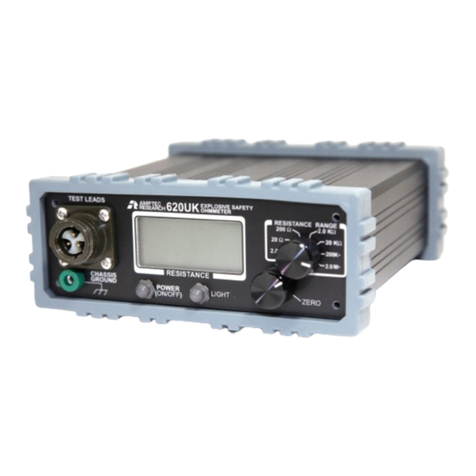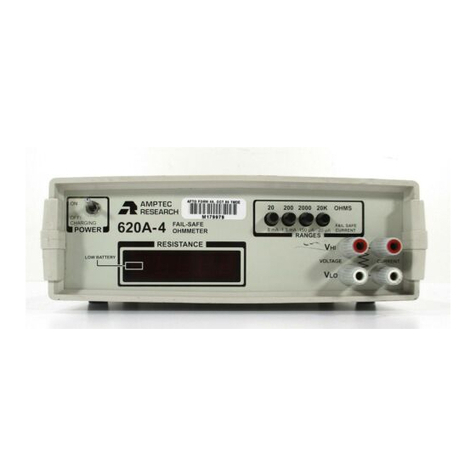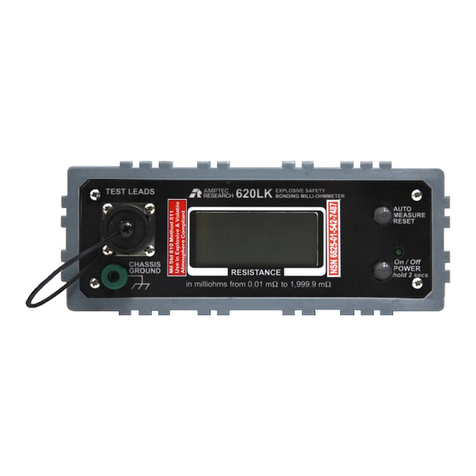
A-1. Introduction to the AMPTEC 620A-4
The AMPTEC 620A and the 630 Series Igniter
Testers/Failsafe Ohmmeters have become the
standard in the Safety Igniter Circuit Test
industry, and are designed to provide extremely
safe and reliable resistance testing of electrically
explosive devices (EEDs) or “current sensitive”
blasting devices. Approvals from various Safety
Boards include, the U.S. Air Force ( 620A-4) for
use on Non-Nuclear munitions provided the
appropriate T.O. is available. In addition the US
NAVAL ORDNANCE CENTER has approved
the AMPTEC 630AN, 630BN and 640N Igniter
Testers and other versions are pending. Some of
the devices the 620A Failsafe Ohmmeter may be
used on include: fuses, squibs, igniters,
warheads, explosive bolts, rocket motor squibs,
drone parachute squibs, automobile air-bag
initiators and many others.
The AMPTEC 620A-4 is a 4-wire Kelvin (i.e.
eliminates contact resistance errors) failsafe
digital ohmmeter which has been designed to
use safe levels of DC current for its DC
resistance measurement. Failsafe Output
Circuitry proprietary to AMPTEC RESEARCH
ensures that test current levels do not exceed the
specified "failsafe current" in a worst-case
component failure situation. The failsafe feature
is tested in every instrument before shipment.
The AMPTEC 620A-4 represents the latest in
ultra-safe Igniter Tester measurements. The
620A-4 (serial numbers 620A4-800 and higher)
Igniter Testers all use the same main printed
circuit board (PCB) referred to as Revision D.
Please check the Appendix of this manual for
any addendums that may apply to any
differences between the newer (rev D.) version
620A-4s and older (rev C.) 620A-4 Igniter
Testers with serial numbers less than 620A4-800
(i.e. 620A4- 525).
Should the rechargeable batteries reach a low
charge level, a minus sign will appear on the
display. The 620A-4 has a
circuit that indicates when to charge the
batteries.
Should the AMPTEC shipping box appear
damaged upon arrival, request that the carrier's
agent (i.e. UPS) be present when the unit is
unpacked. If the 620A 4 appears damaged, the
carrier's agent should authorize repairs before
the unit is returned to the factory. Even if the
instrument appears undamaged, it may have
suffered internal damage in transit that may not
be evident until the unit is operated or tested.
If the unit fails to operate or fails to meet the
performance specifications
of Section B, notify the
carrier's agent and the
nearest AMPTEC Sales
Office. Retain the shipping
carton for the carrier's
inspection.
or any of its sales
offices an RMA number
(Return Material Authorization). We need to
know who to contact and how to contact (i.e.
phone number and FAX number) in order to
properly coordinate the return of the repaired
AMPTEC product. After getting an RMA #
from AMPTEC, against
loss, be sure to also affix an ID label (contact
info) on the lid of the 620A Igniter Tester with
your phone number, name, address and FAX
number, and email address.
we can often troubleshoot and
identify the problem (i.e. battery loose in the
battery holder), over the phone.
battery monitoring
A-2. Receiving, Unpacking, and Initial
Inspection
DO NOT return equipment
to AMPTEC RESEARCH
By calling
AMPTEC RESEARCH, prior to returning
the 620A,
without first obtaining
as an added precaution



































